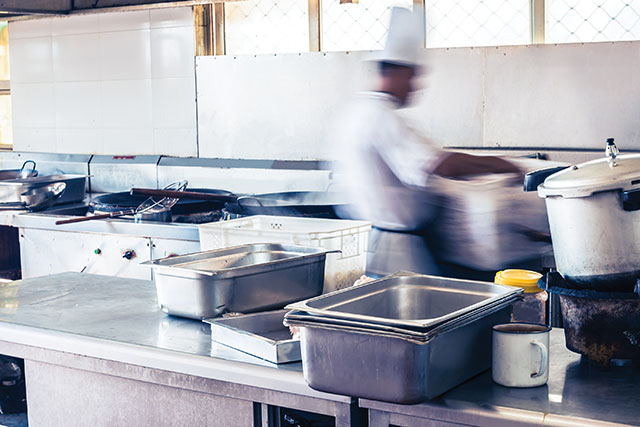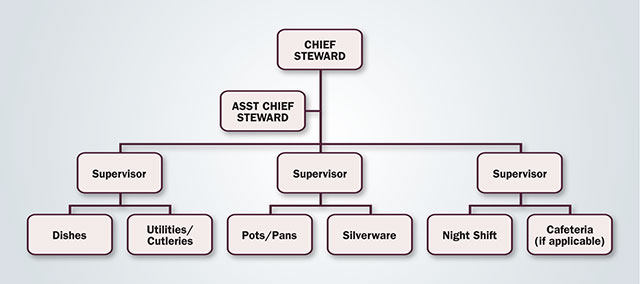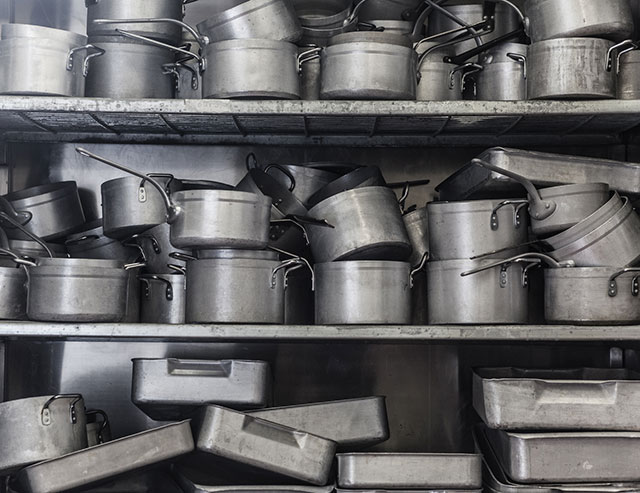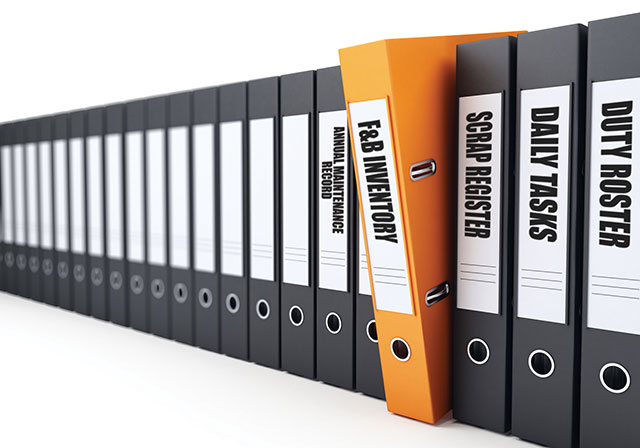
A kitchen, no matter its size should have its system for cleaning which in industry terms, is called ‘stewarding’. The size allocated to your stewarding area depends on the size of your operations and smaller kitchens would have smaller teams. However, what if the kitchen serves 500 people in one service? There will be 500 pieces of dinnerware from appetizers to desserts; not to mention cookware. Usually, the stewarding site will be separate from the kitchen and has its own team. The department comes under the supervision of the Executive Chef although in certain places where stewarding takes up a bigger role, it may directly report to the F&B Manager. With the team having separate roles, a typical organisational chart of the stewarding department is as such:
Chief Steward – oversees all the processes in the department and the total upkeep of the entire food production area, including maintenance of all service equipment and utensils. This person will be the direct contact to the Executive Chef and F&B Manager to ensure that service is prompt.
Assistant Chief Steward – plans, organises, directs and controls all activity in the stewarding area. Ensures that the team is in sync with front-of-house operations.
Supervisors – responsible over a particular segment or shift; reporting to the Chief regarding any activity beyond their jurisdiction.
** The below serves only as an example as the stewarding department is adapted to fit individual establishments’ needs.

THE JOB SCOPE
Apart from cleaning dishes and cookware, the stewarding team’s responsibility also includes:
• Setting up stations for cleaning according to the restaurant’s menu and maintenance routine for the stations, including the receiving bay.
• Providing the correct service equipment according to course of meal.
• Establishing cleaning schedule for all storage points e.g. chillers, freezers, shelves and cabinets as well as ensuring daily cleaning of wet garbage room.
• Drawing up a waste management program; ideally with recycling practices.
• Monitoring maintenance of the circulating pars of material and equipment; scheduling servicing or replenishing of items such as chemicals when required.
• Checking that the foodservice establishment is pestfree and immediately engage an exterminator if any pests are found. In hotels, stewarding usually communicate with Housekeeping to maintain a successful pest control program.
DESIGNING A STEWARDING AREA
The principles of smooth workflow and adequate space for staff to move around comfortably is of essence. Servers are responsible for moving soiled ware from service area and stack them according to its type at the collection table. The washing area comprises 3 sub sections:
Loading: wares are prewashed and loaded on baskets for the dishwasher or passed for hand-washing.
Washing: whether done by machine or hand; it must comprise washing, rinsing and sanitising.
Unloading: kept on racks to be taken by stewards or wait staff for usage.
When designing the work place for stewards, these points must be considered:
• Location of the stewarding/washing station must be as near as possible to foodservice points.
• The washing area serves as a middle point for stewards (deliverers of clean tableware) and servers (receivers) therefore it should mark the area of movement for both categories of staff to ensure that they move in the right direction and flow.
• Various entry and exit points should also be factored and enough floor space as there is always someone walking around – a wait staff bringing dirty dishes and a chef going to the racks to pull out a washed pan and all movement create possibility of untoward incidences.
• Adequate ventilation aligned with the volume of soiled ware or else the area will get too warm with electronic dishwashers running at high capacities. On average, the washing space is about 1/4 of the kitchen.
• Fitted with ample trolleys and large sinks.
• Provide safety boots as floors will definitely get greasy and wet.
• Face masks and gloves should be at easy reach when staff handle chemicals.

How storage should NOT be
STORAGE OF CLEANED WARES
Typically referred to as Silver and Plate room; cleaned dishes and metal tableware are kept on cupboards and shelves according to type. Larger silver items like platters are stored on shelves while earthen ware items go into the cupboard. The person overseeing the store room must always ensure that heavier items are kept at the lower shelves and items stacked according to size and not simply placed to avoid accidents. Cutlery and other small items, for example, menu card holders, table numbers, ashtrays, butter dishes should be kept in drawers. A coarse woolen or cotton fabric; known as baize should line the drawers to prevent noise and sliding of items when the drawer is opened or closed as metal ware will eventually have scratches knocking around each other.

RECORD KEEPING IN DETAIL
Logbooks and filing is an essential part of stewarding and can include items like:
• Log book recording daily tasks carried out by the department.
• Duty roster for fair work distribution and record off days.
• F&B Inventor y that follows equipment’s par ts that were changed or needs change together with regular maintenance schedule.
• Register of breakage to record any broken items and follow-up steps.
• Scrap register of discarded items or equipment.
• Annual maintenance record of all equipment.
• Requisition forms put in by other departments on items requiring procurement.
The stewarding department is as important than any other teams in an establishment because without them; all the hygiene elements of the entire place will be compromised and with records in an disarray; the restaurant manager or owner would be hard pressed to follow up on its maintenance needs.










